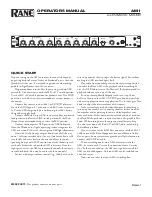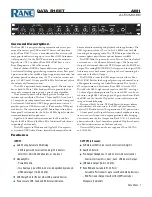
1 – Introduction : The features of the DM-4800
16
TASCAM DM-4800
User’s Manual
Control section
This section contains the screen, the dedicated func-
tion keys, and the PODs, as well as the cursor keys
and the data wheel.
The operation of this section is described in more
detail in “Basic operational concepts” on page 17,
which you should read in order to gain an under-
standing of how the PODs, etc. are used.
Monitoring section
This section contains the controls for the control
room and studio monitoring and cueing controls, as
well as the talkback microphone and slate controls.
The main stereo meters are also in this section.
See “Monitoring” on page 66 for details of this sec-
tion’s operation.
Module & fader layer control section
The faders and module control keys are in this sec-
tion, together with the keys used to select the differ-
ent layers.
See “Fader layers” on page 19 for details of how the
fader layers are used on the DM-4800.
The
SEL
keys are used to select the modules to be
edited. This can also be done with the touch-sensitive
faders.
Encoder section
The use of the encoders is described in “Encoders”
on page 22.
See this section for a complete description of how the
indicators surrounding the encoders are lit when the
encoders perform different functions.
Modifier section (SHIFT & CTRL keys)
These are keys which when pressed and held, affect
the behavior of other keys.
Library section and CF card slot
These keys perform recall, etc. of library entries. The
CF card slot is used with a CF card to store projects
and the data associated with these project.
Machine control section
These controls are used to control a device (external
hardware recorder, or DAW) connected to the DM-
4800 using MIDI, USB or the 9-pin serial control
protocol.
See “Remote operation” on page 105 for details of
how to set up and use these controls in your projects.
Analog input section
These are the built-in mic/line inputs and inserts. See
the details later in this section (“Mic/line connec-
tions” on page 49) for details of how to connect and
use them.
















































